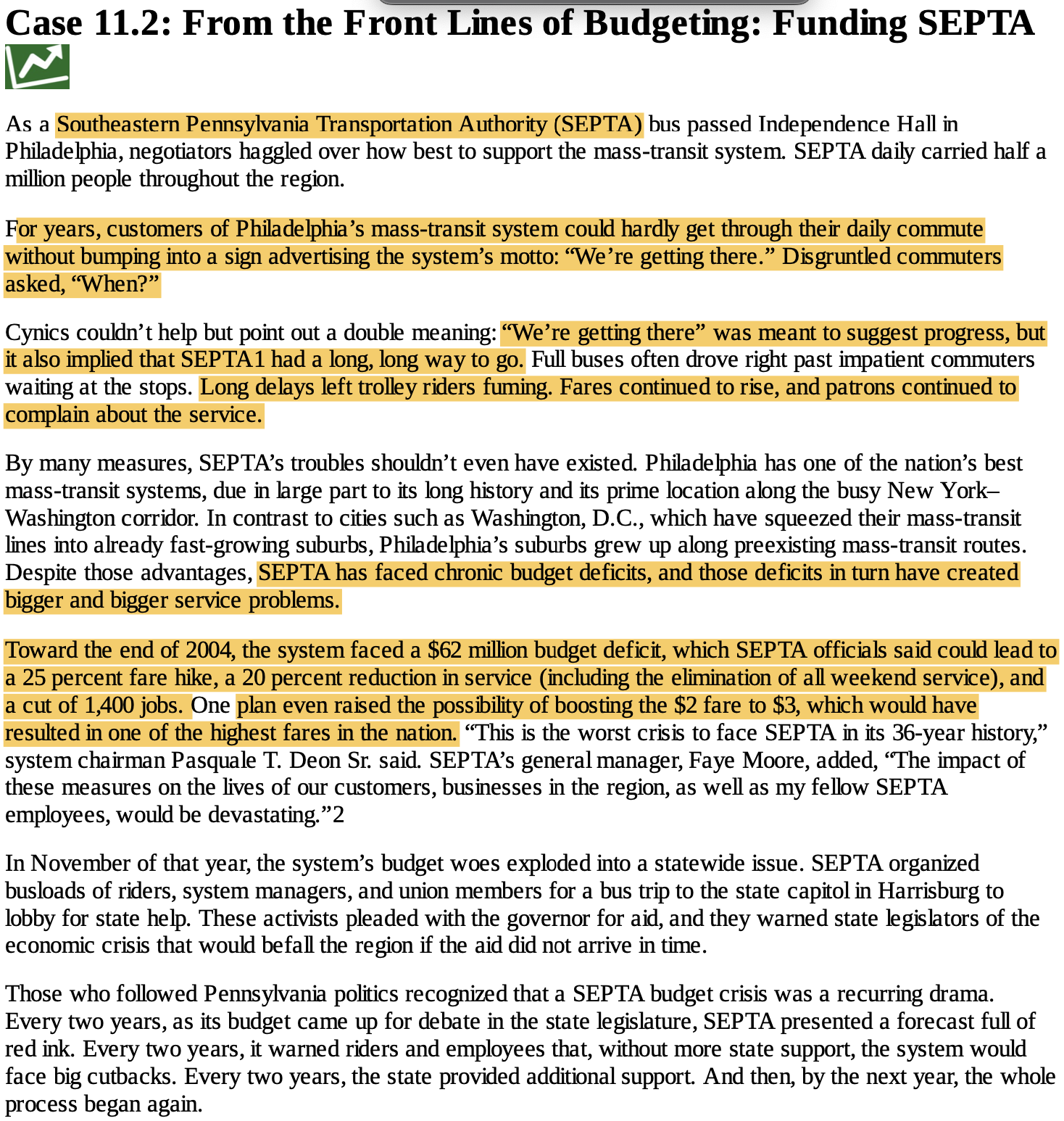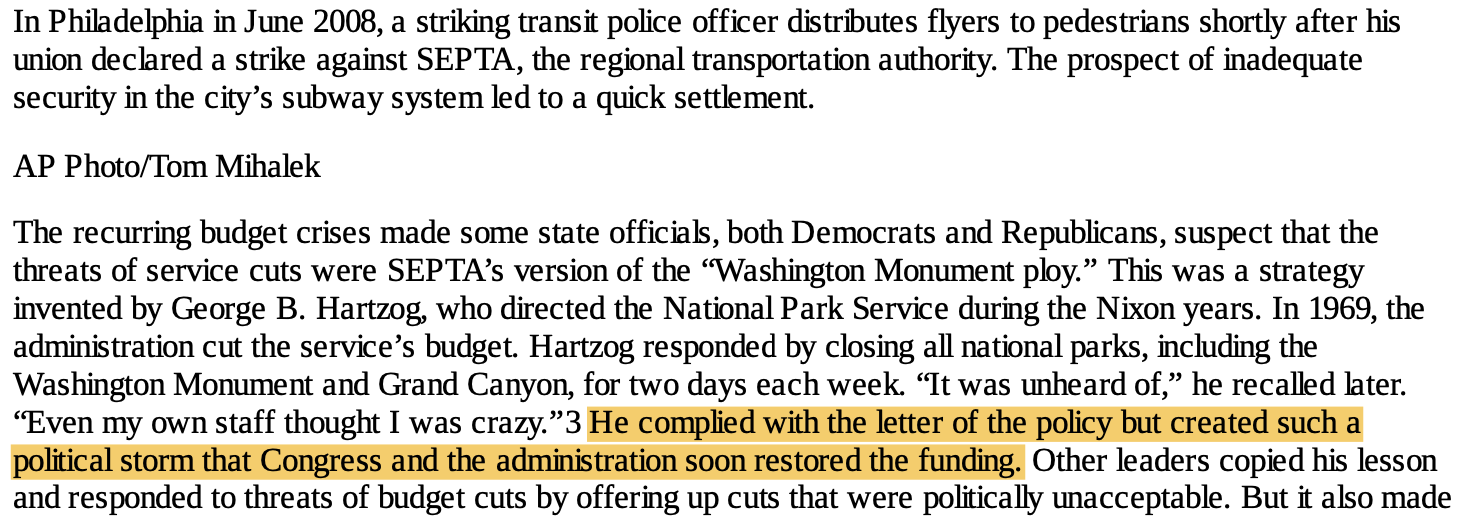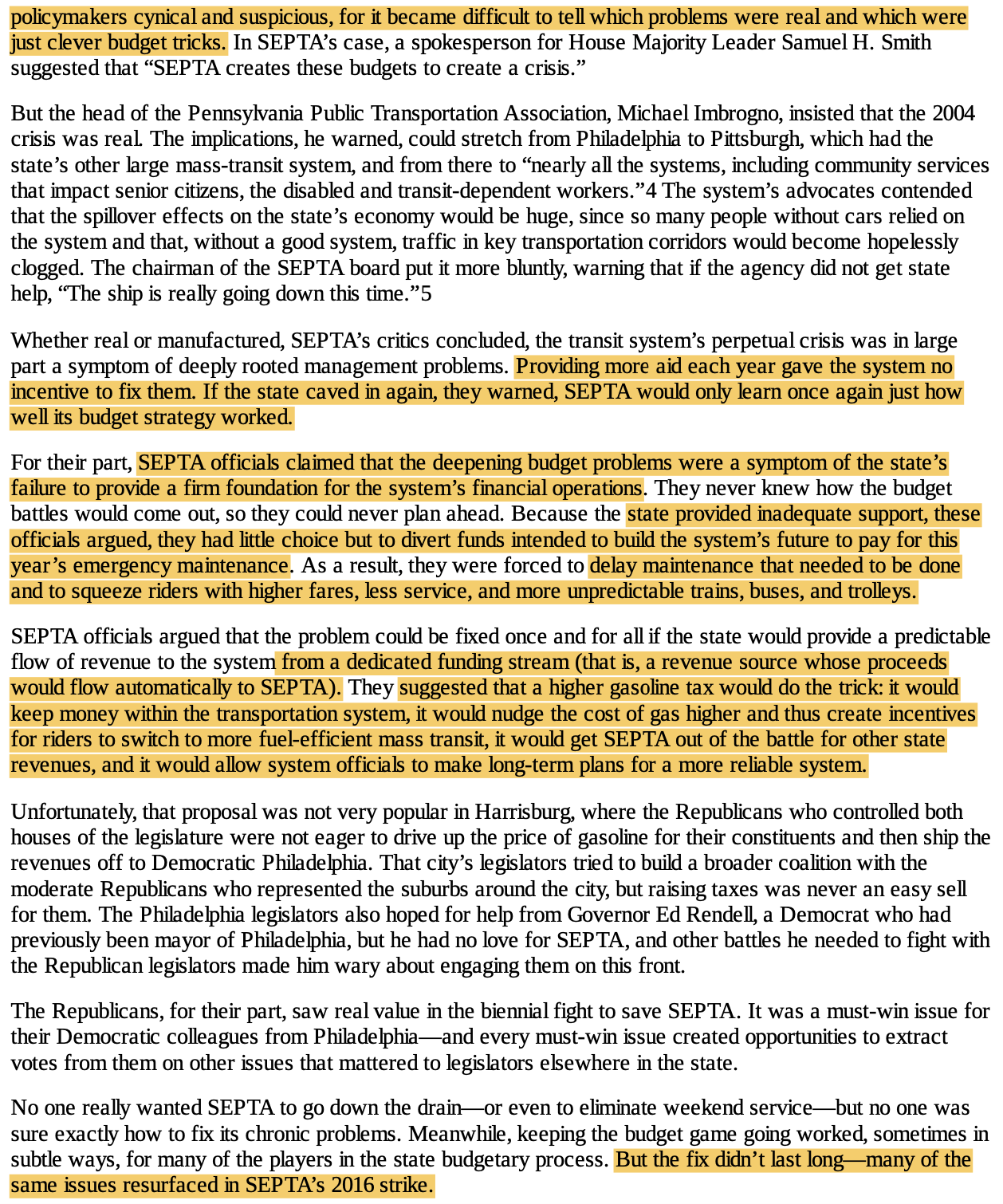Answered step by step
Verified Expert Solution
Question
1 Approved Answer
Case 11.2: From the Front Lines of Budgeting: Funding SEPTA M As a Southeastern Pennsylvania Transportation Authority (SEPTA) bus passed Independence Hall in Philadelphia,




Case 11.2: From the Front Lines of Budgeting: Funding SEPTA M As a Southeastern Pennsylvania Transportation Authority (SEPTA) bus passed Independence Hall in Philadelphia, negotiators haggled over how best to support the mass-transit system. SEPTA daily carried half a million people throughout the region. For years, customers of Philadelphia's mass-transit system could hardly get through their daily commute without bumping into a sign advertising the system's motto: We're getting there. Disgruntled commuters asked, "When? Cynics couldn't help but point out a double meaning: "We're getting there was meant to suggest progress, but it also implied that SEPTA1 had a long, long way to go. Full buses often drove right past impatient commuters waiting at the stops. Long delays left trolley riders fuming. Fares continued to rise, and patrons continued to complain about the service. By many measures, SEPTA's troubles shouldn't even have existed. Philadelphia has one of the nation's best mass-transit systems, due in large part to its long history and its prime location along the busy New York, Washington corridor. In contrast to cities such as Washington, D.C., which have squeezed their mass-transit lines into already fast-growing suburbs, Philadelphia's suburbs grew up along preexisting mass-transit routes. Despite those advantages, SEPTA has faced chronic budget deficits, and those deficits in turn have created bigger and bigger service problems. Toward the end of 2004, the system faced a $62 million budget deficit, which SEPTA officials said could lead to a 25 percent fare hike, a 20 percent reduction in service (including the elimination of all weekend service), and a cut of 1,400 jobs. One plan even raised the possibility of boosting the $2 fare to $3, which would have resulted in one of the highest fares in the nation. This is the worst crisis to face SEPTA in its 36-year history," system chairman Pasquale T. Deon Sr. said. SEPTA's general manager, Faye Moore, added, The impact of these measures on the lives of our customers, businesses in the region, as well as my fellow SEPTA employees, would be devastating.2 In November of that year, the system's budget woes exploded into a statewide issue. SEPTA organized busloads of riders, system managers, and union members for a bus trip to the state capitol in Harrisburg to lobby for state help. These activists pleaded with the governor for aid, and they warned state legislators of the economic crisis that would befall the region if the aid did not arrive in time. Those who followed Pennsylvania politics recognized that a SEPTA budget crisis was a recurring drama. Every two years, as its budget came up for debate in the state legislature, SEPTA presented a forecast full of red ink. Every two years, it warned riders and employees that, without more state support, the system would face big cutbacks. Every two years, the state provided additional support. And then, by the next year, the whole process began again. In Philadelphia in June 2008, a striking transit police officer distributes flyers to pedestrians shortly after his union declared a strike against SEPTA, the regional transportation authority. The prospect of inadequate security in the city's subway system led to a quick settlement. AP Photo/Tom Mihalek The recurring budget crises made some state officials, both Democrats and Republicans, suspect that the threats of service cuts were SEPTA's version of the "Washington Monument ploy." This was a strategy invented by George B. Hartzog, who directed the National Park Service during the Nixon years. In 1969, the administration cut the service's budget. Hartzog responded by closing all national parks, including the Washington Monument and Grand Canyon, for two days each week. "It was unheard of," he recalled later. "Even my own staff thought I was crazy."3 He complied with the letter of the policy but created such a political storm that Congress and the administration soon restored the funding. Other leaders copied his lesson and responded to threats of budget cuts by offering up cuts that were politically unacceptable. But it also made policymakers cynical and suspicious, for it became difficult to tell which problems were real and which were just clever budget tricks. In SEPTA's case, a spokesperson for House Majority Leader Samuel H. Smith suggested that "SEPTA creates these budgets to create a crisis." But the head of the Pennsylvania Public Transportation Association, Michael Imbrogno, insisted that the 2004 crisis was real. The implications, he warned, could stretch from Philadelphia to Pittsburgh, which had the state's other large mass-transit system, and from there to "nearly all the systems, including community services that impact senior citizens, the disabled and transit-dependent workers."4 The system's advocates contended that the spillover effects on the state's economy would be huge, since so many people without cars relied on the system and that, without a good system, traffic in key transportation corridors would become hopelessly clogged. The chairman of the SEPTA board put it more bluntly, warning that if the agency did not get state help, "The ship is really going down this time."5 Whether real or manufactured, SEPTA's critics concluded, the transit system's perpetual crisis was in large part a symptom of deeply rooted management problems. Providing more aid each year gave the system no incentive to fix them. If the state caved in again, they warned, SEPTA would only learn once again just how well its budget strategy worked. For their part, SEPTA officials claimed that the deepening budget problems were a symptom of the state's failure to provide a firm foundation for the system's financial operations. They never knew how the budget battles would come out, so they could never plan ahead. Because the state provided inadequate support, these officials argued, they had little choice but to divert funds intended to build the system's future to pay for this year's emergency maintenance. As a result, they were forced to delay maintenance that needed to be done and to squeeze riders with higher fares, less service, and more unpredictable trains, buses, and trolleys. SEPTA officials argued that the problem could be fixed once and for all if the state would provide a predictable flow of revenue to the system from a dedicated funding stream (that is, a revenue source whose proceeds would flow automatically to SEPTA). They suggested that a higher gasoline tax would do the trick: it would keep money within the transportation system, it would nudge the cost of gas higher and thus create incentives for riders to switch to more fuel-efficient mass transit, it would get SEPTA out of the battle for other state revenues, and it would allow system officials to make long-term plans for a more reliable system. Unfortunately, that proposal was not very popular in Harrisburg, where the Republicans who controlled both houses of the legislature were not eager to drive up the price of gasoline for their constituents and then ship the revenues off to Democratic Philadelphia. That city's legislators tried to build a broader coalition with the moderate Republicans who represented the suburbs around the city, but raising taxes was never an easy sell for them. The Philadelphia legislators also hoped for help from Governor Ed Rendell, a Democrat who had previously been mayor of Philadelphia, but he had no love for SEPTA, and other battles he needed to fight with the Republican legislators made him wary about engaging them on this front. The Republicans, for their part, saw real value in the biennial fight to save SEPTA. It was a must-win issue for their Democratic colleagues from Philadelphia-and every must-win issue created opportunities to extract votes from them on other issues that mattered to legislators elsewhere in the state. No one really wanted SEPTA to go down the drain or even to eliminate weekend service-but no one was sure exactly how to fix its chronic problems. Meanwhile, keeping the budget game going worked, sometimes in subtle ways, for many of the players in the state budgetary process. But the fix didn't last longmany of the same issues resurfaced in SEPTA's 2016 strike. 1. How does the "Washington Monument ploy" work? Do you believe it is likely to be an effective strategy? Will players in the process catch on after an agency has tried it once or twice? 2. How does the regular nature of SEPTA's budget battles affect its ability to plan and operate in the long term? 3. What lessons does the biennial budget game teach about the incentives for those who play it? 4. What options might policymakers consider for fixing SEPTA? What would you recommend?
Step by Step Solution
There are 3 Steps involved in it
Step: 1

Get Instant Access to Expert-Tailored Solutions
See step-by-step solutions with expert insights and AI powered tools for academic success
Step: 2

Step: 3

Ace Your Homework with AI
Get the answers you need in no time with our AI-driven, step-by-step assistance
Get Started


